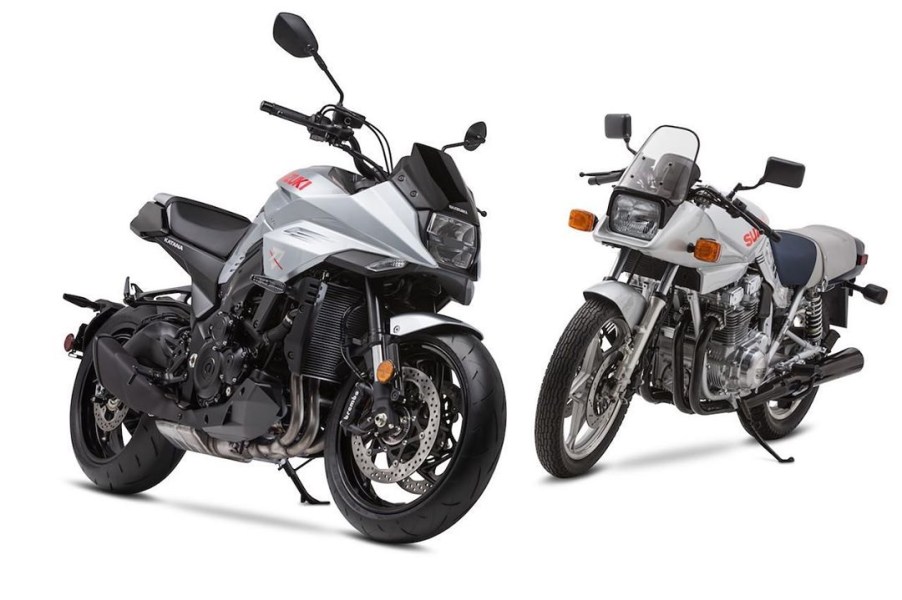
Does the New Suzuki Katana Carve as Well as the Original?
Retro is big right now, especially with motorcycles. Honda’s brought back classic models like the Super Cub, Hunter Cub, and Monkey, for example. Indian has the Scout Bobber. And British manufacturer Triumph has a whole line of neo-classic bikes. Now, Japanese brand Suzuki has also joined in. Although Suzuki still sells cars like the Kizashi sedan and Jimny SUV elsewhere, in the US it’s mostly known for motorcycles, like the DR-Z400S and Hayabusa. And it’s brought back a well-known name from the past, in the form of the Suzuki Katana.
The original Suzuki GS1100 Katana

Although the 1981 Suzuki GS1100 Katan’s angular looks may seem dated today, at the time, Iron and Air explains, it looked like no other Japanese bike. Up until then, Japanese bike makers followed the basic design of the Honda CB750, spawning the ‘Universal Japanese Motorcycle’ segment. However, after roughly a decade of derivative looks, Motorcyclist explains, Suzuki wanted to break out a bit.
The Suzuki Katana, instead of taking inspiration from UJMs, was penned by several ex-BMW motorcycle designers. They also, according to Motorcycle News, incorporated design elements from Italian bikes of the day. The result, Motorcycle Classics reports, was a look sharp enough to end up in New York City’s Guggenheim Museum. Hence the name ‘Katana.’ And it was genuinely functional, too, thanks to wind-tunnel testing. But the rest of the bike was also fairly impressive.
In the US, due to racing homologation restrictions, the Suzuki GS1100 Katana came with a 99-hp 998cc four-cylinder taken from the base GS1100. Which, Bike Insurer reports, was at the time the fastest production motorcycle in the world. This was later bumped up in the GS100SZ, which had a 111-hp 998cc four-cylinder engine. Clip-ons, something still fairly rare at the time, kept the rider tucked in close. And it was the first production bike to feature hydraulic anti-dive forks.

Although an original Suzuki Katana is in some ways fairly modern, the bike was really best at speed, Motorcyclist reports. At a road-legal pace, it shows its age, with slightly awkward handling, buzzy pegs and handlebars, and a rather stiff suspension. Plus, although it’s very stable with the rider tucked in, Motorcycle News reports, rising up causes a lot of turbulence. And side-on winds can cause problems.
The 2020 Suzuki Katana

The 2020 Suzuki Katana isn’t quite as ground-breaking as the original. Its 999cc liquid-cooled fuel-injected four-cylinder, for instance, is derived from the one in the previous-gen GSX-R1000. And its adjustable traction control, Motorcyclist reports, is a bit basic compared to systems found in other sportbikes. But, as a way of carving backroads, the new Katana is a more-than-worthy successor to the name.
Even with a 474-lb curb weight and no clip-ons, Motorcyclist reports, the 2020 Suzuki Katana handles extremely well. Cycle World reports it feels “balanced, predictable, and surprisingly comfortable.” Yet the KYB suspension is still supple enough to iron out deep bumps. And despite its less-advanced design, the traction control’s intervention was smooth and unobtrusive. In addition, Hagerty reports the original Katana was actually about 40 pounds heavier.
The rest of the 2020 Suzuki Katana also benefits from modern engineering and refinement. On Cycle World’s dyno, the 999cc engine put out 140 hp and 76 lb-ft. Yet, the rider feels very little vibration through the handlebar or footpegs. In fact, Suzuki engineers likely chose the older-gen engine for its wide powerband and low-end torque, which make it more enjoyable during street-riding.
The bike also comes with ABS-equipped Brembo brakes as standard, as well as a shift-smoothing slipper clutch. Plus, the Katana features Suzuki’s Low RPM Assist feature, which helps get the bike going from a stop.
Oh, and you can now bring a passenger along for the ride.
Pricing and availability

Original Suzuki Katanas have risen in value, Hagerty reports, in keeping with other 80s and 90s machines. However, these bikes are still relatively affordable; even the best examples top out at about $14,000.
Interestingly, that’s not too far off the 2020 Suzuki Katana’s base price. Including the $395 destination charge, it stickers for $13,894. You can also equip it with additional accessories, like special graphics and a larger windscreen.
So, while it may not be cutting-edge, the 2020 Suzuki Katana is definitely not any duller than the original.
Follow more updates from MotorBiscuit on our Facebook page.


